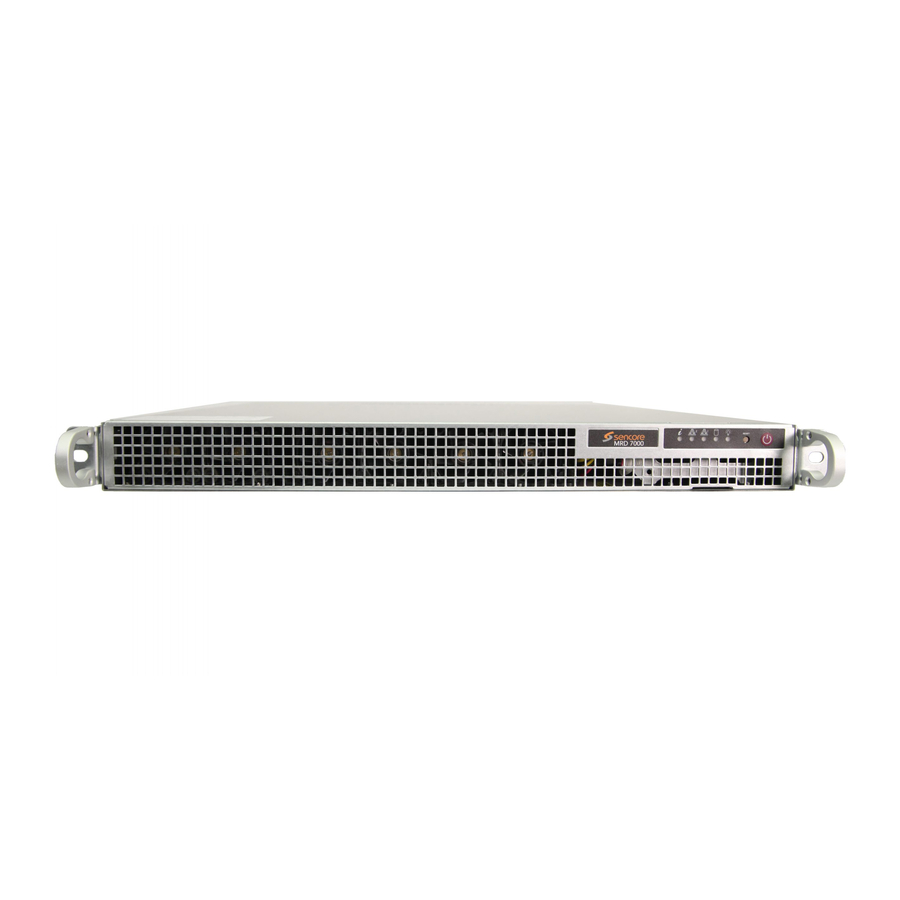
Sencore MRD 7000 Quick Start Manual
Hide thumbs
Also See for MRD 7000:
- User manual (126 pages) ,
- Quick start manual (2 pages) ,
- User manual (56 pages)
Advertisement
Quick Links
Quick Start Guide MRD 7000
About This Quick Start Guide
This guide is for helping new customers get their Sencore MRD 7000 setup and
running as quickly and easily as possible.
The MRD 7000 multichannel multiformat receiver decoder is capable of decoding
HEVC, H.264 and MPEG2 transport streams up to UHD resolutions. Input
options include MPEG/IP, ASI, satellite, Zixi and SRT. Output options include
SDI, HDMI, and ST 2110. No matter the hardware and software options your
MRD 7000 has, accessing the user interface is always the same.
Download the Full User's Manual
The current versions of the full user's manuals can be obtained from the
Download tab of individual product pages on our website:
by emailing Sencore ProCare support at procare@sencore.com.
Unpack the Equipment
Check that there are no signs of damage to equipment due to transport. If the
equipment appears to be damaged, please contact Sencore ProCare for support.
In addition to the Sencore MRD 7000 hardware itself, the box should include
power cables or AC adapters and various rackmount hardware.
Equipment Installation and Power Up
The MRD 7000 server hardware is designed for rack installation and should be
securely connected to the rack using the included rack rails and screws suitable
for the rack type. Note that there should be sufficient room for air to freely flow
around the unit, ensuring proper cooling. The chassis requires front-to-back
airflow.
The MRD 7000 server hardware is specified to operate in the range of 100–
240VAC, 50-60Hz
Form 8176B
www.sencore.com
or
NOTE: I/O modules can vary depending on options. For details on connecting
ASI, RF, SDI, HDMI, or ST 2110 see the full user's manual.
Establish a Web Connection to the MRD 7000
To access the MRD 7000 web user interface, it is necessary to establish an
Ethernet connection to the device. There are two alternative ways to connect to
or set the device's management IP address: using the pre-set management IP
address or connecting a monitor and keyboard to the server.
Using the Pre-Set Management IP Address
The Sencore MRD 7000 is shipped with the following factory settings for the
network ports:
eth0 Default IP Address:
eth0 Default Subnet Mask:
eth1 Default IP Address:
To connect to the web UI, the PC used for setup should have corresponding
network settings. Connect a PC directly to eth0 using an Ethernet cable.
Version 1.2 – July 2020
2
1
3
Figure 3: MRD 7000 Rear Port Connectors
1.
Dual Power Connectors: Provides AC power connection for powering
the system
2.
IPMI Port: Can be used for remote server management, but not
normally used in the MRD 7000 operation
3.
eth0 Port: Network port for management and IP input.
4.
eth1 Port: Network port for management and IP input.
5.
VGA Monitor Output
10.0.20.101
255.255.0.0
DHCP
5
4
Page 1
Advertisement

Summary of Contents for Sencore MRD 7000
- Page 1 Quick Start Guide MRD 7000 About This Quick Start Guide This guide is for helping new customers get their Sencore MRD 7000 setup and running as quickly and easily as possible. The MRD 7000 multichannel multiformat receiver decoder is capable of decoding HEVC, H.264 and MPEG2 transport streams up to UHD resolutions.
- Page 2 Properties — Internet Protocol Version 4 Properties view, as shown in figure It is also possible to configure the network settings of the MRD 7000 using a 2. Select the user defined address and set the PC’s IP address to 10.0.20.60 and monitor and keyboard connected directly to the server.
- Page 3 Figure 5: MRD 7000 Web UI Login Screen Define Decoder Configuration Once logged in, the main screen of the MRD 7000 is displayed. Click on the Decoder tab to begin configuring the MRD 7000 for operation. Figure 4: MRD 7000 Console Configuration Screen Connect to the Web User Interface of the MRD 7000 Launch a web browser application on the management PC.














Need help?
Do you have a question about the MRD 7000 and is the answer not in the manual?
Questions and answers